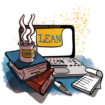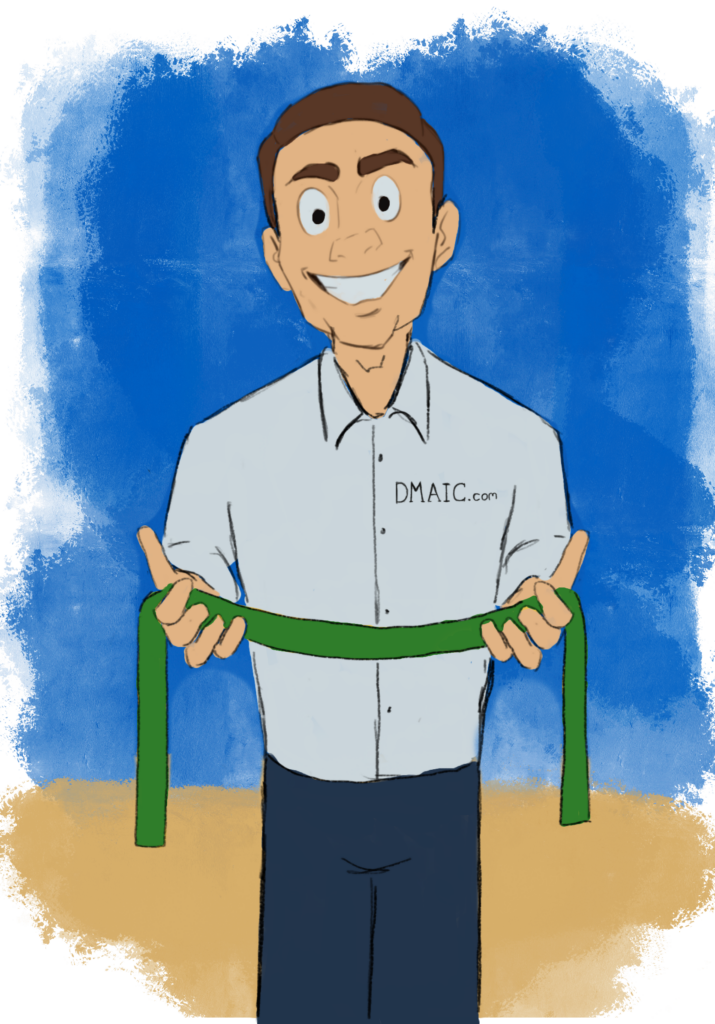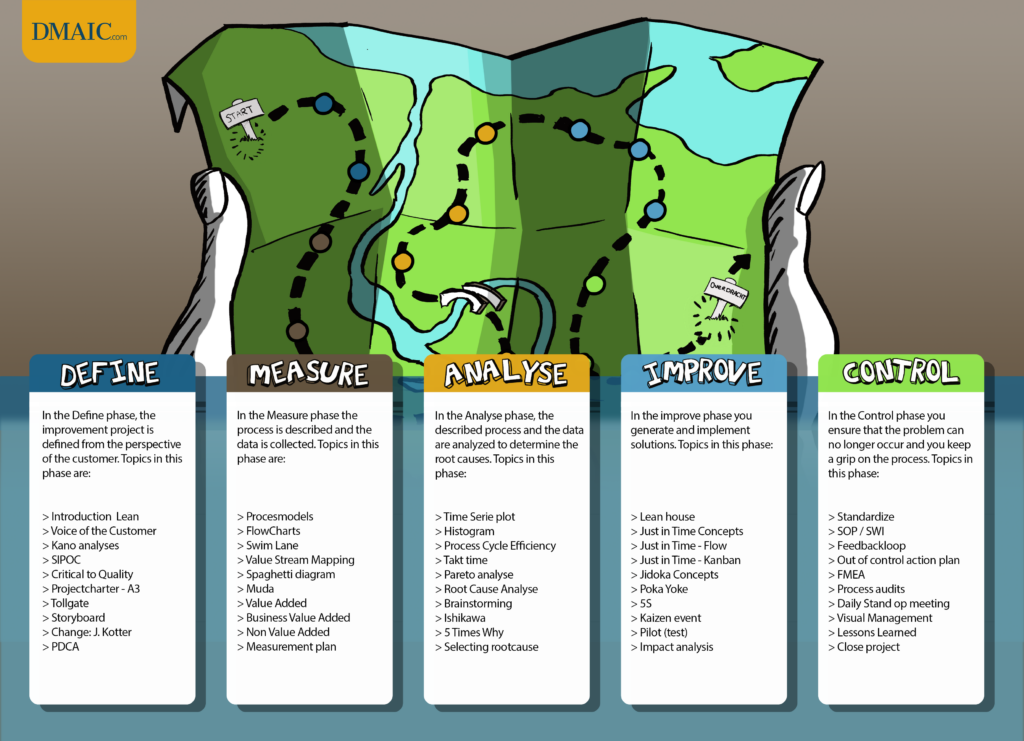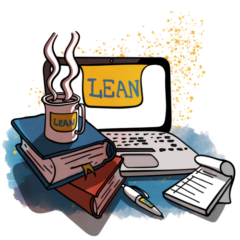-
How it works
How does it work?
Dmaic.com offers comprehensive and fully accredited online Lean training.
Read more Online packagesOnline trainingClassroom trainingsClassroom and in-company training
Online packagesOnline trainingClassroom trainingsClassroom and in-company trainingDmaic.com also offers classroom Lean and Lean Six Sigma training courses Read more
- Pricing
- Companies
- Knowledge
 Knowledge baseWant to know more about Dmaic and what Dmaic means for other companies? Check the Dmaic.com knowledge base.
Knowledge baseWant to know more about Dmaic and what Dmaic means for other companies? Check the Dmaic.com knowledge base. Online WorkshopsDon't immediately choose a course for you: do you want the knowledge and tools with which you can get started right away? Then a Dmaic-workshop is for you.
Online WorkshopsDon't immediately choose a course for you: do you want the knowledge and tools with which you can get started right away? Then a Dmaic-workshop is for you.- About
Understanding the Role of a Green Belt

What is a Green Belt?
Green Belts are trained leaders of improvement projects, responsible for spearheading these initiatives and fostering a culture of continuous improvement. With Lean Green Belt training, you become the driving force behind continuous improvement within your organization. You will gain an in-depth understanding of the Lean philosophy and master techniques to address improvement challenges and lead change initiatives.
Key Aspects of Being a Green Belt
- Familiarization with Lean principles.
- Independent execution of improvement initiatives.
- Problem-solving in processes.
- Leading workshops and eliminating waste.
Lean is a methodology focused on minimizing waste and maximizing customer value. It employs various roles, or ‘belts,’ each with specific responsibilities in improving organizational processes. This blog discusses these roles, outlining their tasks and responsibilities.
The Colorful World of Lean Belts
Often, you will hear people talk about the color of a belt, like Green Belt and Black Belt. In Lean, this concept is borrowed from the (Budo) martial arts of Japan. With this belt system, employees are given a role in the hierarchy.

Roles in Lean Methodology
In Lean methodology, several key roles or ‘belts’ play a pivotal part in process improvement and organizational efficiency. Each belt represents a specific set of skills and responsibilities:
Champion
As the foremost Lean role, the Champion or Sponsor, typically part of the executive or management team, fervently supports Lean’s implementation. They ensure the seamless progression of improvement projects, guide Black Belts in project selection, and align these initiatives with the organization’s strategic objectives. Champions possess the authority to allocate necessary resources and personnel.
Process Owner
The Process Owner, usually a line manager, oversees the process that requires enhancement. They initiate and act as clients for individual improvement projects. Their responsibilities encompass staffing, leading Tollgate meetings, implementing solutions, and ensuring successful outcomes. Process Owners also provide support to Black and/or Green Belts.
Master Black Belt (MBB)
MBBs play a crucial role in embedding Lean and fostering a culture of continuous improvement. They mentor and train Black Belts, offering assistance in executing improvement projects.
Black Belt
Black Belts, as the lead figures in improvement projects, bear the responsibility for their execution. They possess a deep understanding of Lean Six Sigma principles, tools, and techniques. Black Belts engage in problem-solving, team dynamics management, role assignment, and are adept in DMAIC and Lean concepts. They focus on identifying and reducing non-value-adding activities and spearheading transformative Lean projects.
Green Belt
Green Belts support Black Belts in project implementation. Trained in various Lean methods and techniques, they lead smaller projects and contribute significantly to the spread of Lean philosophy within the organization. Green Belts have substantial knowledge of the DMAIC framework and typically work under Black Belt supervision to analyze and solve quality issues within their specific areas of expertise.
Orange Belt
At an intermediate level, Orange Belts delve into the Lean methodology more deeply. They lead Yellow Belts and support Green Belts in process improvement projects, addressing more complex problems and enhancing efficiency.
Yellow Belt
Also known as Orange Belts, Yellow Belts have foundational training in Lean principles. They participate in improvement projects by assisting in workshops, gathering data, and contributing to team efforts. Yellow Belts support the team in process mapping and identifying potential areas for improvement, often acting as specialists or core team members and handling smaller projects under the guidance of Green or Black Belts.
White Belt
White Belts are subject matter experts within their departments, involved in projects but not receiving specialized Lean training. As an entry-level category, White Belt training offers a fundamental understanding of Lean principles and terminology, ideal for those new to the field and seeking a general overview of Lean methodology.
Each belt in Lean plays a crucial role, contributing uniquely to the continuous improvement and operational efficiency of an organization.
What is the Role of a Green Belt?
When fostering a culture of continuous improvement, I always train several Black Belts and numerous Green Belts. This approach is adopted because Green Belts play a critical role both within the organization and in their respective departments.
As a Green Belt, you become the champion actively contributing to a culture of continuous improvement. You will acquire comprehensive knowledge on how to execute improvement initiatives, identify waste, implement quick wins, and apply commonly used Lean techniques. Your ability to independently lead and organize improvement initiatives will make you a key driver of continuous improvement in your organization. Mastery of Lean philosophy and the skills to solve improvement challenges are fundamental aspects of your role. Additionally, your capacity to inspire and lead others through improvement and change processes will be invaluable.
Responsibilities of a Green Belt
- Understanding and applying Lean principles.
- Identifying and eliminating waste to boost efficiency.
- Systematically tackling problems with sustainable solutions.
- Leading Lean implementations and facilitating workshops.
- Implementing quick wins and driving continuous improvement.
- Analyzing data for fact-based decision-making and improvement support.
- Communicating effectively and collaborating with stakeholders at various levels across the organization.
In summary, as a Green Belt, you will make a significant contribution to process improvement and the cultivation of a continuous improvement culture within your organization.
PDCA and DMAIC: The Green Belt’s Toolkit
The Green Belt possesses profound knowledge of PDCA (Plan-Do-Check-Act) and is adept in applying DMAIC (Define, Measure, Analyze, Improve, Control) principles.
Here’s a structured breakdown of the DMAIC phases that a Green Belt is skilled in:
Define
This initial phase involves clearly defining a problem and assessing its potential for improvement. Key topics include project selection, understanding customer needs, conducting brown paper exercises, navigating tollgates, creating SIPOC diagrams, developing storyboards and project charters, and facilitating team building. These skills are crucial for establishing clear project objectives and effectively engaging all relevant stakeholders.
Measure
In the measurement phase, Green Belts visualize and describe process flows and analyze value streams. This encompasses mastering Value Stream Mapping, Swimlane diagrams, Material and Information Flow Analysis (MIFA), the Universal Diagram of Manufacturing Operations (UDMO), crafting a measurement plan, and identifying the eight types of waste in Lean. These competencies enable a comprehensive understanding and measurement of current processes, highlighting areas ripe for improvement.
Analyze
This phase focuses on analyzing processes, assessing their effectiveness, and identifying root causes of problems. Green Belts work with tools such as Lean measurements, Run Charts, Histograms, Control Charts, brainstorming, Ishikawa diagrams, Pareto Charts, and the “5 Whys” technique. These tools facilitate a deeper exploration of processes to uncover and understand the underlying causes of issues.
Improve
During the improvement phase, Green Belts actively engage their teams in implementing enhancements. This involves organizing stand-up meetings, setting up improvement boards, conducting simulations, and encouraging team-based solution generation. Techniques such as Kaizen, Kaikaku, Training Within Industry (TWI), Flow, Pull, Single Minute Exchange of Die (SMED), Kanban, Just-in-Time (JIT) production, and identifying TIMWOODS (the eight wastes) are applied to drive significant improvements.
Control
Beyond achieving results, the control phase focuses on maintaining those results. Green Belts establish procedures, conduct Failure Mode and Effects Analysis (FMEA), use RACI diagrams for role definition, apply the 8D method for problem-solving, conduct audits, and implement visual management. These strategies are essential for sustaining improvements and promoting ongoing enhancement.

In addition to these technical skills, Green Belts also emphasize softer skills such as change management and team dynamics, which are equally vital for the success of improvement projects.
Summary and Conclusion: The Role and Impact of a Lean Green Belt
A Green Belt is a valuable designation in Lean methodology, equipping individuals with the knowledge and skills to lead improvement projects and foster a culture of continuous improvement within their organizations. As a Lean Green Belt, one plays a crucial role in driving continuous improvement, gaining a deep understanding of Lean philosophy, and mastering techniques to address improvement challenges and lead change initiatives.
Key responsibilities of a Green Belt include:
- Gaining familiarity with Lean principles.
- Independently executing improvement initiatives.
- Solving problems in processes.
- Leading workshops and eliminating waste.
Lean methodology focuses on minimizing waste and maximizing customer value, encompassing various ‘belts’ or roles, each with specific responsibilities in organizational improvement. These roles range from the Champion or Sponsor at the executive level to the White Belt, which represents foundational knowledge in Lean principles.
The Green Belt role is particularly vital in an organization, significantly contributing to process improvement and the establishment of a continuous improvement culture. Green Belts are responsible for:
- Applying Lean principles in daily work.
- Recognizing and eliminating process waste.
- Systematically addressing problems with sustainable solutions.
- Actively participating in Lean implementations.
- Leading workshops and facilitating team involvement in improvement initiatives.
- Implementing quick wins for immediate results.
- Independently executing improvement initiatives.
- Utilizing data analysis for informed decision-making.
- Communicating and collaborating effectively across the organization.
Furthermore, Green Belts possess a comprehensive understanding of PDCA (Plan-Do-Check-Act) and DMAIC (Define, Measure, Analyze, Improve, Control) methodologies, which are crucial in the various phases of process improvement.
In conclusion, Lean Green Belts play a pivotal role in enhancing organizational efficiency and effectiveness. They are not only technical experts in Lean methodologies but also adept in softer skills such as change management and team dynamics. The training and application of Lean Green Belt principles enable individuals to lead and make significant contributions to continuous improvement within their organizations, thereby driving positive change and fostering a culture of efficiency and excellence.
Online Lean Green Belt Training
Will You Be the Driving Force Behind Continuous Improvement?
Discover the power of Lean and learn how to lead teams and organisations towards continuous improvement. Are you ready to play a crucial role in the continuous improvement of your organisation? Our online Lean Green Belt training enables you to independently lead improvement and change initiatives. Learn the art of Continuous Improvement. Do you feel that the processes within your department could be better and more efficient? Our Lean Green Belt e-learning provides you with the knowledge and skills to lead your organisation towards continuous improvement.

